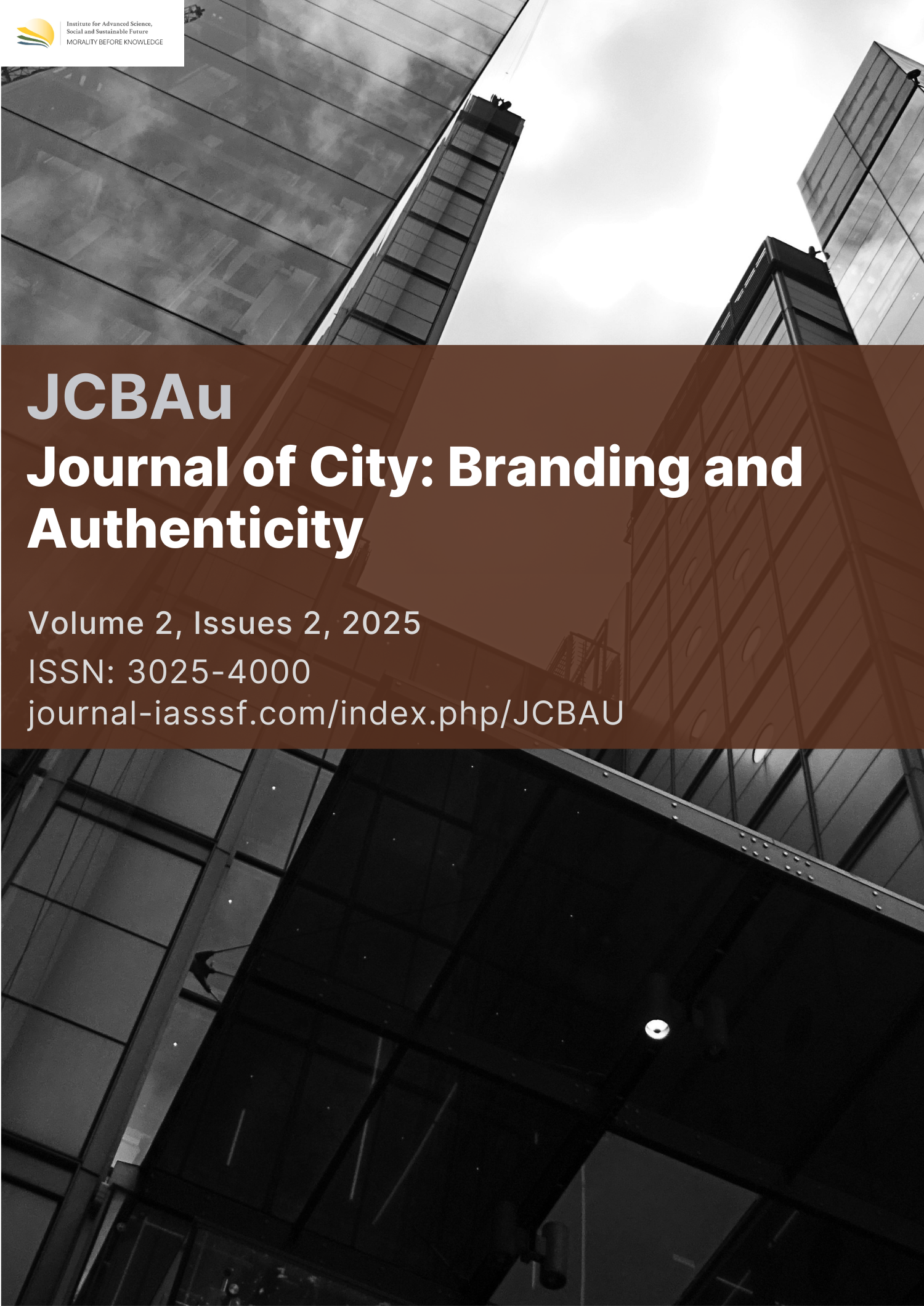Layers of authenticity: Tracing multicultural narratives in the goethe-institut building as a symbol of urban branding in yangon
DOI:
https://doi.org/10.61511/jcbau.v2i2.2025.1422Keywords:
adaptive reuse, architectural authenticity, heritage conservation, multicultural architecture, sustainable urban developmentAbstract
Background: This study investigates the Goethe-Institut building in Yangon, Myanmar, highlighting its significance as a case of adaptive reuse and heritage conservation. Constructed in the 1920s during British colonial rule, the building showcases a blend of architectural styles, merging colonial engineering with Burmese, Chinese, and Indian design elements. Over the years, it has transitioned from a private residence to a revolutionary headquarters, an art school, and now serves as a cultural hub. Methods: This study examines the Goethe-Institut building in Yangon, Myanmar, through site observations, historical analysis, and a literature review, focusing on its architectural significance and role in heritage conservation. Findings: The research delves into the building's historical evolution and architectural features while addressing the challenges of adaptive reuse within urban heritage conservation. It emphasizes how these strategies have preserved historical authenticity while meeting contemporary needs and sustainability goals. Key elements such as high ceilings, wide verandas, and intricate carvings are analyzed for their cultural significance. By comparing similar projects across Southeast Asia, the study illustrates the potential of heritage conservation to enhance cultural identity and community engagement. It argues that the Goethe-Institut exemplifies the transformative power of adaptive reuse in preserving architectural heritage, offering insights for sustainable urban development and postcolonial narratives. Conclusion: The findings underscore the importance of integrating historical context with modern functionality to foster resilience in urban environments. Novelty/Originality of this article: This study provides a unique contribution by analyzing the Goethe-Institut building in Yangon as a case of adaptive reuse, highlighting its role in preserving architectural heritage while addressing contemporary sustainability challenges, and offering comparative insights from similar projects across Southeast Asia.
References
Amro, D. K., Sukkar, A., Yahia, M. W., & Abukeshek, M. K. (2023). Evaluating the Cultural Sustainability of the Adaptive Reuse of Al-Nabulsi Traditional House into a Cultural Center in Irbid, Jordan. Sustainability, 15(17), 13198. https://doi.org/10.3390/su151713198
Bahauddin, A., & Soon, T. B. (2019). The environment and feng shui application in cheong fatt tze mansion, Penang, Malaysia. WIT Transactions on the Built Environment, 183, 1-13. https://doi.org/10.2495/arc180011
Bandarin, F., & van Oers, R. (2012). The historic urban landscape: Managing heritage in an urban century. Wiley-Blackwell. https://doi.org/10.1002/9781119968115
Bennet, M. A., Narendran, A. N., & Jothilakshmy, N. (2024, August). Preserving Architectural Legacy: Adaptive Reuse Strategies And Community Engagement In Haveli Dharampura And TELC Church Governor’s Residence. In 2024 9th International Conference on Applying New Technology in Green Buildings (ATiGB) (pp. 512-517). IEEE. https://doi.org/10.1109/ATiGB63471.2024.10717666
Bhabha, H. K. (1994). The location of culture. Routledge. https://doi.org/10.4324/9780203820551
Brooker, G., & Stone, S. (2018). Rereading adaptive reuse. Routledge.
Bullen, P. A., & Love, P. E. (2011). Adaptive reuse of heritage buildings. Structural survey, 29(5), 411-421. https://doi.org/10.1108/02630801111182439
Chang, J.-H. (2016). Thermal comfort and climatic design in the tropics: An historical critique. The Journal of Architecture, 21(8), 1171–1202. https://doi.org/10.1080/13602365.2016.1255907
Conejos, S., Langston, C., Chan, E. H. W., & Chew, M. Y. L. (2016). Governance of heritage buildings: Australian regulatory barriers to ad aptive reuse. Building Research & Information, 44(5–6), 507–519. Crossref. https://doi.org/10.1080/09613218.2016.1156951
Dovey, K. (2019). Becoming places: Urbanism, architecture, identity, power. Routledge.
Eusterbrock, L. (2022). Climate-conscious popular music education: Theory and practice. Journal of Popular Music Education, 6(3), 385–401. https://doi.org/10.1386/jpme_00098_1
Ibtissem, B., & Meriama, B. (2024). Colonial heritage: A resource for local development in el harrouch, Algeria. International Journal of Innovative Technologies in Social Science, 2(42). https://doi.org/10.31435/rsglobal_ijitss/30062024/8177
ICOMOS. (2019). The ICOMOS charter for the interpretation and presentation of cultural heritage sites. International Council on Monuments and Sites. https://www.icomos.org/images/DOCUMENTS/Charters/interpretation_e.pdf
Jokilehto, J. (2017). A history of architectural conservation. Routledge. https://doi.org/10.4324/9781315636931
Langston, C. (2011). Green adaptive reuse: Issues and strategies for the built environment. In Modeling risk management in sustainable construction (pp. 199-209). Springer Berlin Heidelberg. https://doi.org/10.1007/978-3-642-15243-6_23
Li, Y. (2024). The Chinese in Colonial Myanmar. In Y. Li, Oxford Research Encyclopedia of Asian History. Oxford University Press. https://doi.org/10.1093/acrefore/9780190277727.013.835
Maha Shree J, Yogesvar R, Madhushri R, Vishal R, & Eunice J. (2024). Adaptive Reuse of Cultural Heritage. International Research Journal on Advanced Engineering and Management (IRJAEM), 2(04), 1188–1192. https://doi.org/10.47392/IRJAEM.2024.0158
Ming, H., & Jakub, Ś. (2024). Assessing the environmental benefits of adaptive reuse in historical b uildings. A case study of a life cycle assessment approach. Sustainability in Environment. https://doi.org/10.1080/27658511.2024.2375439
Mydin M., Salim N., M. Sani N., & Y. Khaw Y. (2014). Evaluation of Imminent Fire Hazards of Inheritance Ancestral Temple an d Mansion in Georgetown, Penang. https://doi.org/10.1051/E3SCONF/20140301030
Narayanan, Y. (Ed.). (2015). Religion and Urbanism: Reconceptualising sustainable cities for South Asia (0 ed.). Routledge. https://doi.org/10.4324/9781315798066
Pendlebury, J. (2021). Conservation in the age of sustainability. Routledge. https://archive.org/details/conservationinag0000pend
Roberts, J. L. (2017). Heritage-making and post-coloniality in Yangon, Myanmar. Citizens, civil society and heritage-making in Asia, 40-60. https://doi.org/10.1355/9789814786294-004
Roberts, J. L. (2018). In search of urban identities in Myanmar. In R. Padawangi (Ed.), Routledge Handbook of Urbanization in Southeast Asia. Routledge. https://doi.org/10.4324/9781315562889-36
Saarinen, J. (2006). Traditions of sustainability in tourism studies. Annals of Tourism Research, 33(4), 1121–1140. https://doi.org/10.1016/j.annals.2006.06.007
UNESCO. (2011). Recommendation on the historic urban landscape. United Nations Educational, Scientific and Cultural Organization. https://whc.unesco.org/document/160163
UNESCO. (2020). Urban heritage in Southeast Asia: Challenges and strategies. United Nations Educational, Scientific and Cultural Organization. https://unesdoc.unesco.org/ark:/48223/pf0000260641
Vale, L. (2019). Architecture, power, and national identity. Routledge. https://doi.org/10.4324/9781315880921
World Monuments Fund. (2020). Preserving the past, building the future: Heritage sites in developing cities. WMF Publications. https://www.wmf.org/press-releases/world-monuments-fund-announces-2020-world-monuments-watch
Yangon Heritage Trust. (n.d.). A guide to Yangon’s historical sites. https://www.yangonheritagetrust.org/
Yapp, L. (2020). The future in the past: Colonial modernity as urban heritage in contemporary Indonesia. South East Asia Research, 28(2), 178–198. https://doi.org/10.1080/0967828X.2020.1768801
Downloads
Published
How to Cite
Issue
Section
Citation Check
License
Copyright (c) 2025 May Thinzar Win

This work is licensed under a Creative Commons Attribution 4.0 International License.
















